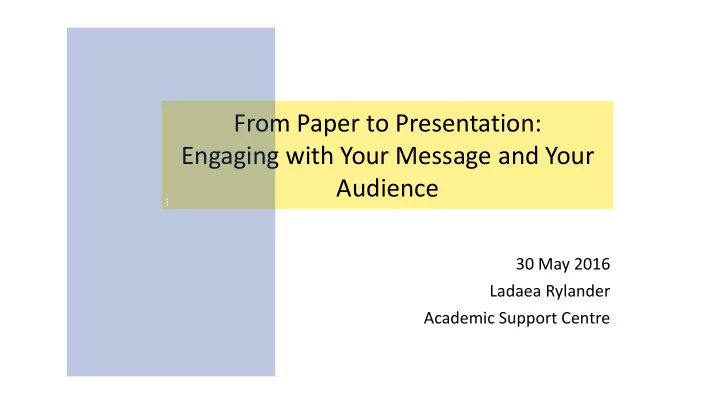

From Paper to Presentation: Engaging with Your Message and Your Audience … 30 May 2016 Ladaea Rylander Academic Support Centre
Why are good presentation skills important?
From Paper to Presentation A presentation is about an IDEA (not a paper)
Planning Phase Who? What? Why? & How?
Structure Many options for structure; • Introduction: Greeting & The Hook (1-2 slides) BEGINNING here are three • Methods: (1 slide) • Results: 3-5 points with evidence (3-5 slides) MIDDLE • Discussion: with results? separate slide? • Conclusion: Summary & Significance (TAKE AWAY) END (1 slide)
Structure • Introduction: Opener, problem/question, motivation, give away the ending (?), forecast structure (1-2 slides) • Methods: (1 slide) • Results: 3-5 points with evidence (3-5 slides) MIDDLE • Discussion: with results? separate slide? • Conclusion: Summary & Significance (TAKE AWAY) END (1 slide)
Structure • Introduction: Greeting, problem/question, motivation, give away the ending (?), forecast structure* (1-2 slides) • Methods: (1 slide) • Results: 3-5 points with evidence (3-5 slides) • Discussion: combine with results or separate slide(s)? • Conclusion: Summary & Significance (TAKE AWAY) END (1 slide)
Structure • Introduction: Greeting, problem/question, motivation, give away the ending (?), forecast structure (1-3 slides) • Methods: (1 slide) • Results: 3-5 points with evidence (3-5 slides) • Discussion: combine with results or separate slide(s)? (3 if separate) • Conclusion: Summary (main result) & Significance (takeaway!) (1 slide)
Structure • Introduction: Opener, problem/question, motivation, give away the ending (?), forecast structure (1-3 slides) • Subtopic 1 (2-3 slides) • Method (?) • Result & discussion • Mini-conclusion • Subtopic 2 (2-3 slides) • Method (?) • Result & discussion • Mini-conclusion • Subtopic 3 (2-3 slides) • Method (?) • Result & discussion • Mini-conclusion • Conclusion: Summary (main result) & Significance (takeaway!) (1 slide)
Structure • Introduction: Opener, problem/question, motivation, give away the ending (?), forecast structure (1-3 slides) • Theory (2-3 slides) • Premise from theory #1 • Premise from theory #2 • Relevance for upcoming topics • Subtopic 1 (2 slides) • Claim • Evidence (results & discussion) • Subtopic 2 (2 slides) • Claim • Evidence (results & discussion) • Subtopic 3 (2 slides) • Claim • Evidence (results & discussion) • Conclusion: Summary (main result) & Significance (takeaway!) (1 slide)
Signposting : verbal punctuation (Key phrases handout)
Audience Interest • Hook • ”You,” ”we,” ”our” • Relevant anecdotes, stories, and examples • Audience involvement • Direct or rhetorical questions • Clarity & conciseness • Attitude • Varied media “How to give a successful oral presentation.” Catalysis.nl. Web. March 2013.
Audience Interest Depending on your content, you can: • Use a great opening (story, anecdote, humor…,often followed - up on at the end)
Audience Interest Depending on your content, you can: • Use a great opening (story, anecdote, humor…often followed-up on at the end) • Make the abstract concrete: tell stories, use concrete examples, make numbers tangible • Use ”You,” ”we,” ”our” • Reflect the attitude you want the audience to adopt • Vary your media (but don’t drown in it!)
• Visual aids can go really wrong. It’s never a good idea that your visual aids trump you as the presenter. They shouldn’t be your script, either. • PowerPoint has, unfortunately, encouraged lots of people to present slides (or worse…just read them) instead of deliver a speech. • Not inspiring • PowerPoint also has many terrible effects, transitions, and clip art made much too available. Ignore most of these. • How do you like reading entire sentences as bullet points? • How do you like my reading entire sentences as bullet points on the screen that you can read faster than I can speak? • Hey look! A cat!
Bad slide example from: http://nobullets.files.wordpress.com/2009/05/bad-slide- s2191_epa_analysis-44.jpg
Less is (usually) more
Tools for creating dynamic communication GROUNDING balance, presence INT INTENSITY body: openness voice: volume, tone, strength DI DIRECTION body: gesture, eye contact, placement voice: follows through and inclusive TEMPO pauses speed variations
Create your own take-home message: What three things will you work on for your defenses?
Academic Academic writing Support Presenting Centre Study skills ASCatLU english.support@stu.lu.se www.lunduniversity.lu.se/academic-support
Recommend
More recommend